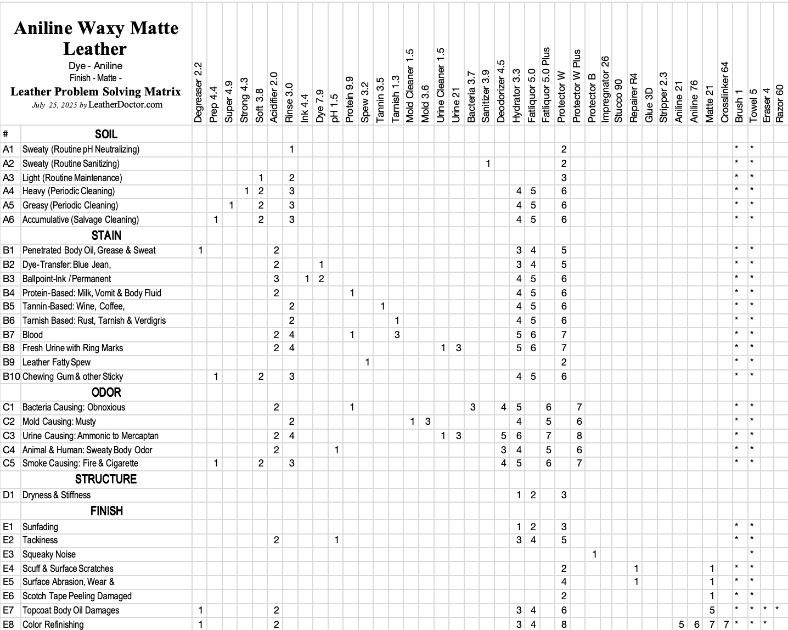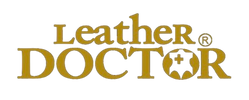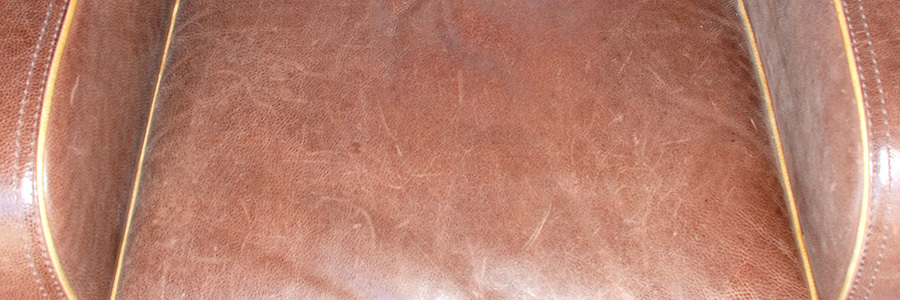Aniline Waxy Matte Leather Dye Refinishing Kit AM3.cl by Leather Doctor degrease, acidify, clean, rinse, hydrate, fatliquor, dye, seal, and condition waxed leather.
Aniline Waxy Matte Leather is a full-grain chrome-tanned leather known for its soft hand and transparent aniline-dyed color that enhances its natural beauty. The dye penetrates through to the reverse suede side, creating a rich, natural look with a subtle Sauvage effect. Its fine waxy matte finish is achieved through an emulsion topcoat, which is further protected with a non-stick, rub-resistant conditioner to minimize finish wear.
As an amphoteric material, Aniline Waxy Matte Leather is pH-sensitive, requiring leather-safe products with a pH between 3 and 5 to prevent potential damage. If exposed to alkaline substances, it must be pH-balanced back to its neutral state (iso-electric point or pI) to maintain its integrity. Additionally, aniline leathers are more UV-sensitive, making periodic hydration and fatliquoring essential for preventing dryness, reviving color vibrancy, and maintaining suppleness to avoid stiffness and cracking.
Kit AM3.cl requires 1435g (1.6 quarts) of distilled waterto be mixed and filled before use, and products are available individually as refills to complete your project.
Kit AM3.cl Product Summary Includes:
✅ Degreaser 2.2
✅ Soft 3.8
✅ Rinse 3.0
✅ Acidifier 2.0
✅ Hydrator 3.3
✅ Fatliquor 5.0
✅ Dye 21
✅ Matte 21
✅ Protector W
✅ Brush 1
✅ Foam Brush 2
✅ Towel 5
✅ Leather Eraser 4
✅ Sandpaper 2000
Leather Degreaser 2.2 by Leather Doctor® is a professional-grade, water-based solution formulated to remove body oils, grease, and sweat from leather surfaces.
Deep-Cleansing, Leather-Safe Degreaser for All Leather Types:
Degreaser 2.2 Key Benefits:
- Ideal for use on headrests, armrests, collars, cuffs, handles, and steering wheels, this powerful cleaner penetrates deep to lift embedded grime while maintaining the integrity of the leather.
- With a pH value of 2.2, Degreaser 2.2 is leather-safe and prevents common issues like dye bleeding and surface damage. Unlike harsh solvent-based alternatives, it cleans effectively without drying out or weakening the leather structure.
- Suitable for all leather types—including absorbent and sensitive finishes like Nubuck and suede—Degreaser 2.2 is an essential tool for restoring and preserving leather’s natural beauty, softness, and longevity.
Leather Soft Cleaner 3.8 by Leather Doctor® is a leather-safe, pH 3.8 mild cleaner formulated to effectively emulsify and lift general soiling without causing common side effects.
- Soft 3.8 is among the mildest of cleaners with a lower cleaning power than Strong 4.3 and Super 4.9.
Why Choose Soft 3.8?
- Soft 3.8 is the mildest among the Leather Doctor's range of cleaners which is safe for all leather, nubuck, and suede.
- Always test clean with Soft 3.8 and evaluate the result to your satisfaction before progressively increasing the cleaning power to Strong 4.3 or Super 4.9.
- Accumulated soiling may require the next level of Prep 4.4 preparatory cleaners.
- Penetrated body oil, grease, and sweat requires Degreaser 2.2 and is rinsed with Acidifier 2.0.
- Provides the “just right” strength—a balance between under-cleaning and over-cleaning.
- Part of a holistic leather-safe system: always follow rinse with Rinse 3.0
Soft 3.8 Key Benefits:
- Gently Cleans Without Harsh Effects – Maintains leather’s natural integrity
- Works Seamlessly with Prep 4.4 and Prep 7.7 – Allows for after cleaning of sticky residue
- Prevents Rings & Browning – Ideal for pH-sensitive leathers
- Residue-Free with Rinse 3.0 – Restores leather’s pH balance for long-term care
Leather Rinse 3.0 by Leather Doctor is a pH 3.0 leather-safe rinse formulated to remove suspended soil and restore the pH balance of leather, ensuring its structural integrity and long-term durability.
Rinse 3.0 Key Features & Benefits:
- Removes Suspended Soil – Lifts and extracts emulsified soiling for a clean, residue-free finish.
- Neutralizes Alkaline Residue – Restores pH balance to prevent damage from alkaline overexposure.
- Prevents Tackiness & Dye Bleeding – Stabilizes the leather structure, reducing unwanted texture changes.
- Enhances Leather’s Ionic Charge – Recharges the leather with a positive (+ve) charge, improving its ability to bond with negatively (-ve) charged tanning agents, dyestuff, and fatliquor.
- Preserves Suppleness & Durability – Helps maintain the leather’s softness, preventing stiffness and cracking.
Leather Acidifier 2.0 by Leather Doctor® is a pH 2.0 acidic rinse designed to control, neutralize, and restore leather’s natural pH balance.
Acidifier 2.0 prevents leather from denaturing, which can lead to bleeding, streaking, tackiness, and structural weakness due to alkaline overexposure.
- Neutralizes alkaline contamination from cleaners, sweat, and body oils
- Prevents dye bleeding and color streaking
- Reduces leather tackiness and improves texture
- Strengthens leather fibers and enhances structural integrity
Leather Hydrator 3.3 is a leather-safe pH 3.3 aqueous solution formulated by Leather Doctor® to hydrate, relax, and restore the leather’s internal structure during cleaning, conditioning, and restoration processes - in line with its tannery science-based function:
It mimics the hydration stage of tannery pre-conditioning to prepare leather for deeper structural rejuvenation.
Hydrator 3.3 Key Benefits:
- Rehydrates dried, stiff, or collapsed fiber structure
- Restores moisture to the leather’s protein fibers, relaxing them so they can regain flexibility.
- Essential before fatliquoring (with Leather Fatliquor 5.0) so fats and oils can penetrate deeply and bond properly.
- Displaces and flushes out impuritie
- Helps suspend and wick out residual body oils, sweat, soiling, or alkaline contamination that may have penetrated the leather.
- Balances pH and readies leather for further treatments
- The mild acidic pH of 3.3 re-aligns the ionic charges of the leather structure, making it receptive to fatliquor and protecting against pH damage.
- Helps reduce stiffness and restore suppleness
- When used alone or in conjunction with fatliquor, Hydrator 3.3 is critical for achieving uniform softness, without patchiness.
Tannery science basis
- In professional tanning and retanning, hides are hydrated before fatliquoring or coloring to ensure that treatments penetrate evenly and bond effectively.
- Leather Hydrator 3.3 replicates this essential tannery hydration step at the restoration stage, particularly for dried-out, stiff, or aged leather.
Aniline Staining Dye 21 by Leather Doctor® is a new-generation, water-based transparent staining dye based on tannery science principles designed specifically for all absorbent leathers.
Aniline 21 Key Features:
- Transparent:
- Water-based, transparent, penetrating dye that behaves like traditional tannery stains.
- Brilliant Staining Effect:
- Enhances the natural beauty, depth, and character of the leather grain or nap rather than concealing it.
- Lively, rich color:
- Produces more vibrant and vivid results compared to most conventional liquid dyes.
- Superior lightfastness & fade resistance:
- Offers better UV stability and longer-lasting color than standard liquid dyes.
- Water-based & leather-safe:
- Compatible with Leather Doctor’s tannery science-based care system, ensuring no harm to the leather’s structure or pH balance when used as directed.
- Flexible color shading:
- Can be diluted with distilled water or Leather Hydrator 3.3 for lighter, custom color shades.
Purpose
Aniline Staining Dye 21 is formulated for:
- Re-dyeing faded Aniline leathers
- Reviving color on Nubuck and Suede
- Creating uniform or shaded effects while allowing natural markings and grain to remain visible
- Maintains the natural breathability of absorbent leather.
Application Methods
- Applied using lint-free towels, foam brushes, varnishing brushes, or airbrush (recommended) for best control and evenness without over-wetting.
- Can be layered to build up color intensity.
Leather Fatliquor 5.0 by Leather Doctor® is a leather-safe pH 5.0 emulsion of fat, oil, and water designed to replenish the original fatliquor content of leather’s fibrous structure.
It restores leather’s internal lubrication, flexibility, strength, and resilience—mimicking the essential fatliquoring stage in professional tanning and retanning processes.
Fatliquor 5.0 Key Benefits:
- Lubricates and nourishes the leather structure
- Fatliquor 5.0 deposits fat and oil molecules that bond to the amphoteric protein fibers.
- These lubricate the fibrils, allowing them to slide over each other without stiffness, brittleness, or cracking.
- Reinforces tensile strength and elasticity
- Proper fatliquoring prevents fiber embrittlement and maintains leather’s natural strength and softness.
- Restores suppleness and prevents future damage
- Leather loses fatliquor over time due to aging, heat, sunlight, alkaline exposure, or cleaning.
- Replenishing it prevents shrinkage, stiffness, and cracks.
- Provides long-term structural protection
- Maintains leather’s dimensional stability and ability to flex without damage.
Tannery science basis:
- In the tannery, fatliquoring is one of the final and most critical stages after tanning and dyeing.
- It ensures that leather stays soft, strong, and flexible as it dries.
- The fats and oils form a molecular film around the protein fibers, acting as internal lubricants.
Fatliquor 5.0 brings this same process to leather restoration.
It ensures the leather is not just “looking good on the surface” but structurally rejuvenated from within.
Aniline Waxy Matte Coating Dye 21 by Leather Doctor is a next-generation transparent surface coating dye that provides excellent color coverage with a waxy matte.
This vivid and bright dye coats the leather surface rather than penetrating it, offering enhanced color intensity and uniformity. It can be applied over existing bronzing-stained dye effects, such as Aniline 21, or over existing finishes to enrich and revitalize the leather’s appearance.
Aniline Finish Topcoat Waxy Matte 21 by Leather Doctor® is a water-based sealing topcoat formulated with fine particle-size urethane waxy resins.
Matte 21 provides a matte luster and a distinct waxy feel, perfectly suited to preserve and enhance waxed aniline leathers while maintaining their natural aesthetic and soft texture.
This wax-enriched topcoat is ideal for upholstery, handbags, garments, and saddlery, offering superior durability, flexibility, and resistance against friction, oxidation, and dye migration.
Matte 21 Key Features:
- Matte finish with a waxy feel of hand.
- Tough and flexible urethane resin formulation.
- Seals and protects aniline dyes.
- Retains the natural look and softness of the leather.
- Recommended for professional-grade refinishing and rejuvenation.
Leather Protector W by Leather Doctor® is a matte, soft, waxy-feel, non-stick, rub-resistant conditioner designed to enhance and protect leather while maintaining a refined, natural appearance.
Features & Benefits:
- Matte, Waxy-Feel Conditioning - Provides a soft, luxurious touch without an artificial gloss
- Non-Stick Formula - Shields against sticky soiling and prevents dirt buildup
- Rub-Resistant Protection - Reduces friction wear, scuffing, and stretching for extended leather durability
- Refined Appearance - Enhances the leather’s natural beauty with a finer, non-glossy finish
- Offers the same benefits as Protector W, but with an added luxurious leather scent
Instruction:
1 Degreasing with Leather Degreaser 2.2
- Degreaser 2.2 is shaken well to coagulate.
- It is saturated to reach penetrated soiling with appropriate brushes and erasers and extracted with Towel 5 equivalent until it shows clean.
- It is reapplied and allowed to dwell 3 to 30 minutes or before it dries for a complete soiling suspension and extracted until it shows clean.
2 Cleaning with Leather Soft 3.8
- Before use, the Soft 3.8 concentrate, a ratio of 1 to 64, is mixed with 224g distilled water, or 1.5 inches from the top of the 8oz bottle.
- It is shaken well, applied, and brushed with leather Brush 1 and towel extract until the towel shows clean.
3 Rinsing with Leather Rinse 3.0
- Before use, the Rinse 3.0 concentrate, a ratio of 1 to 80, is mixed with 224g distilled water, or 1.5 inches from the top of the 8oz bottle.
- It is shaken, applied, and brushed with Leather Brush 1 and extracted with a towel until it shows clean and the leather takes a squeaky, healthy feel.
4 Acidifying Rinse with Leather Acidifier 2.0
- Before use, the Acidifier 2.0 concentrate, a ratio of 1 to 25, is mixed with 224g distilled water, or 1.5 inches from the top of the 8oz bottle.
- It is applied directly, brushed, and extracted with Towel 5 until clean.
- It is kept for 3 to 30 minutes to control dye bleeding or surface tackiness.
- Treatment is complete with a test for a healthy squeaky feel.
5 Hydrating with Leather Hydrator 3.3
- Before use, the Hydrator 3.3 concentrate, a ratio of 1 to25, is mixed with 218g of distilled water, or 1.5 inches from the top of the 8oz bottle.
- It is applied from the surface or accelerates saturation by working on the reverse side for a quick darkening effect.
- A 3 minutes to 72 hours dwell to activate dormant dyestuff to resurface for an effective relaxing results.
- Creases, wrinkles, or shrinkage is stake, massage, and stretch to dimension ready for fatliquoring.
- Leaving overnight for long dwell, Mold Killer 3.6 may be needed to control potential mold growth.
6 Softening with Leather Fatliquor 5.0
- Before use, the Fatliquor 5.0 concentrate, a ratio of 1 to 5, is mixed with 189g warm distilled water, or 1.5 inches from the top of the 8oz bottle.
- It is applied and redistributed with appropriate brushes or pads until the thickness of the leather is saturated.
- The application is repeated each time water content evaporates, until it absorbs no more.
- Sticky residue is further driven into the leather structure or rinsed off with Hydrator 3.3.
- Fatliquored leather is left to dry naturally for extra softness.
- Fatliquored leather is further staked, massaged, flexed or stretched accordingly with a little wet back with Hydrator 3.3 until dry for extra suppleness.
- Surface tension is also inspected with Hydrator 3.3 using a folded towel to check for even absorbency, avoiding blotchiness ready for Dye 21.
7 Dyeing with Aniline Waxy Matte Coating Dye 21
- Before use, the Dye 21 concentrate, a ratio of 1 to 1, is mixed with 57g distilled water, or 1 inches mark from the top of the 4oz bottle.
- Check for surface tension with Hydrator 3.3 to ensure free of surface grease to avoid poor adhesion.
- Use Adhesor 73 to ensure proper adhesion.
- It is applied onto the surface of the leather by Foam 2, folded Towel 5, or airbrushing for the desired result.
8 Conditioning with Leather Protector W
- Before use, Protector W concentrate, a ratio of 1 to 19, is mixed with 215g distilled water, or 1.5 inches from the top of the 8oz bottle.
- It is shaken, applied, and spread with a Foam 2 or folded Towel 5 and is ready to use when dry.
9 How to Identify Leather Stains?
Stain identification is crucial for effective treatment and is based on six key factors:
Appearance, Odor, Color, Feel-of-Hand, Location, and Buildup or Absorption.
1. Appearance
Observing the stain looks can indicate whether it is a spill, rub-on, penetration, or surface deposit.
Some stains may cause dye or finish damage, revealing changes in the leather’s color or texture.
2. Odor
Smelling the stain can help identify its source.
Common odors include:
- Moldy (fungal growth)
- Smoke (fire or cigarette exposure)
- Putrid (decaying organic matter)
- Ammonia (urine contamination)
3. Color
Color provides a clue to the staining substance but can change over time due to oxidation.
The leather’s natural color may also influence how the stain appears.
- Red stains: Could be from wine, blood, lipstick, nail polish, or beverages.
- Blood stains: Blood can oxidize, shift from red to tan, and then black.
4. Feel-of-Hand
Touching the stain helps determine its type:
- Sticky: Likely from candy, beverages, or sugary substances.
- Brittle and stiff: This could indicate nail polish, paint, or shellac.
- Greasy smear: Often caused by lipstick, oils, or butter.
5. Location
The stain’s location on the leather provides hints about its origin.
- Headrests & armrests: Usually stained by body oil, sweat, and grease.
- Seat cushions: Often show food or beverage spills.
6. Buildup or Absorbed?
Stains can be surface-level (built-up) or deeply absorbed into the leather.
- Built-up stains (common on pigmented leather) include paint, food residue, and ink.
- Absorbed stains (common on nubuck, aniline, and unfinished leather) include wine, tea, and coffee.
- Combination stains: Some stains contain absorbed and surface elements, such as lipstick, ink, and mustard.
- Protein-based stains: Examples include blood, dairy, and egg-based spills.
- Oil-based stains: Often come from grease, butter, and lotions.
- Colloidal stains: These may require specialized treatments.
7. Additional Considerations:
- Sweat stains can chemically alter leather, causing tackiness (when dry) or sliminess (when wet).
- Dye stains may show when wiping with a white towel—indicating color crocking.
- Fatliquor leaching (spew) appears as a milky film and causes leather to become stiff and prone to cracking.
By carefully identifying the stains, you can apply the appropriate Leather Doctor® specialty product system to restore leather to its original beauty.

9 How to Use the Aniline Waxy Matte Leather Problem-Solving Matrix?
The matrix categorizes common issues with aniline leather into five groups: Soil, Stain, Odor, Structure, and Finish (listed in the left column). Corresponding recommended products are displayed across the top row. Each number within the matrix indicates the steps required to address the problem holistically.
For example:
If a leather issue involves an unknown compound that combines soil, stain, and odor, follow the sequence across the matrix, combining necessary steps from each category. The process should always conclude with:
- Hydrator 3.3 to rehydrate and relax the leather.
- Fatliquor 5.0 to replenish lost fats and oils, restoring suppleness.
- Protector W conditioning the leather for ongoing durability.
10 Technical Help and Support?
- Technical help and support are available free from the link below:
- https://www.leathercleaningrestorationforum.com/forum/forumdisplay.php?5-Leather-Upholstery-Forum
Thank you for your input on improving this writing. Comments are welcome!
Edited: March 16, 2025 by Roger Koh.

















